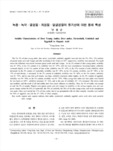

-
 * 본 문서는 배포용으로 복사 및 편집이 불가합니다.
* 본 문서는 배포용으로 복사 및 편집이 불가합니다.
미리보기
서지정보
· 발행기관 : 한국식품영양학회
· 수록지 정보 : 한국식품영양학회지 / 23권 / 1호
· 저자명 : 이진영
영어초록
The 2%, 3% of deer young antler, deer antler, oystershell, crabshell, eggshell were add into the 5%, 10%, 15% solution of glacial acetic acid and vinegar and after incubating it for 4 days at 30℃ respectively, solubility was analyzed. The result shows the difference was minute between glacial acetic acid and vinegar. In the 2% content of deer young antler, solubility was 42~47%, in the 3% content of it, solubility was 41~47%, with the acid concentration becoming higher, solubility increased slightly. In the 2% content of deer antler, solubility was 59~63%, in the 15% content of acid, solubility rather decreased. In the 2% content of oystershell, solubility was 85~96%, in the 3% content, solubility was 95~98%, in the 15% of acid density, it decreased. In the 2% content of crabshell, solubility was 79~88%, in the 3% content, solubility was 81~95%, and in case that acid density was high, solubility increased rather slightly. In the 2% content of eggshell, solubility was 84~96%, in the 3% content, solubility was 84~93%. When young deer antler and deer antler were heated for two hours at 100℃, solubility increased 19~24%, and in the case of crabshell, 10~11% increased. The above result and condition, and the result of pH and acidity don`t have much influence on solubility. Thus, the 5% of acidity was enough to melt the 3% of sample. Highest were glacial acetic acid and vinegar in solubility to the various organic acid, and wax gourd vinegar melted the 85% of oystershell, the 78% of crabshell, the 28% of the deer young antler, and in the precipitation was made. Citric acid melted the 57% of deer antler, but it was precipitated with all other samples. Ascorbic acid melted the 92% of eggshell, and did the 37~54% of other samples.참고자료
· 없음 -
자료후기
-
자주묻는질문의 답변을 확인해 주세요

꼭 알아주세요
-
본 학술논문은 (주)코리아스칼라와 각 학회간에 저작권계약이 체결된 것으로 AgentSoft가 제공 하고 있습니다.
본 저작물을 불법적으로 이용시는 법적인 제재가 가해질 수 있습니다. -
해피캠퍼스는 구매자와 판매자 모두가 만족하는 서비스가 되도록 노력하고 있으며, 아래의 4가지 자료환불 조건을 꼭 확인해주시기 바랍니다.
파일오류 중복자료 저작권 없음 설명과 실제 내용 불일치 파일의 다운로드가 제대로 되지 않거나 파일형식에 맞는 프로그램으로 정상 작동하지 않는 경우 다른 자료와 70% 이상 내용이 일치하는 경우 (중복임을 확인할 수 있는 근거 필요함) 인터넷의 다른 사이트, 연구기관, 학교, 서적 등의 자료를 도용한 경우 자료의 설명과 실제 자료의 내용이 일치하지 않는 경우
“한국식품영양학회지”의 다른 논문도 확인해 보세요!
-
쌀 입국 제조시 Rhizopus sp. ZB9의 배양 조건이 유기산 생성에 미치는 영향 6 페이지
-
다제내성 Acinetobacter baumannii에 유효한 방선균 B-51의 탐색 및 이 균주가 생산하는 항생물질 발효 최적.. 7 페이지
-
대학생의 커피전문점 이용 실태와 선택 속성에 관한 연구 -성남 지역을 중심으로- 11 페이지
-
Avrami Kinetics에 적용한 트레할로스와 변성 전분 혼합 사용 떡의 노화 억제 분석 6 페이지
-
Vitamin C가 방사선과 Aflatoxin B1을 투여한 흰쥐의간 기능 효소 활성 및 간 손상에 미치는 효과 9 페이지
-
정가4,000원
-
지식판매자
-
페이지7 페이지
어도비 PDF
-
최초등록일2016.04.01
-
최종저작일2010.03
-
찾으시던 자료가 아닌가요?
지금 보는 자료와 연관되어 있어요!
문서 초안을 생성해주는 EasyAI




